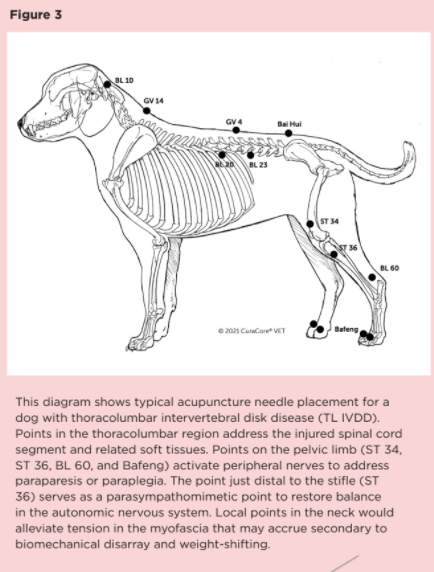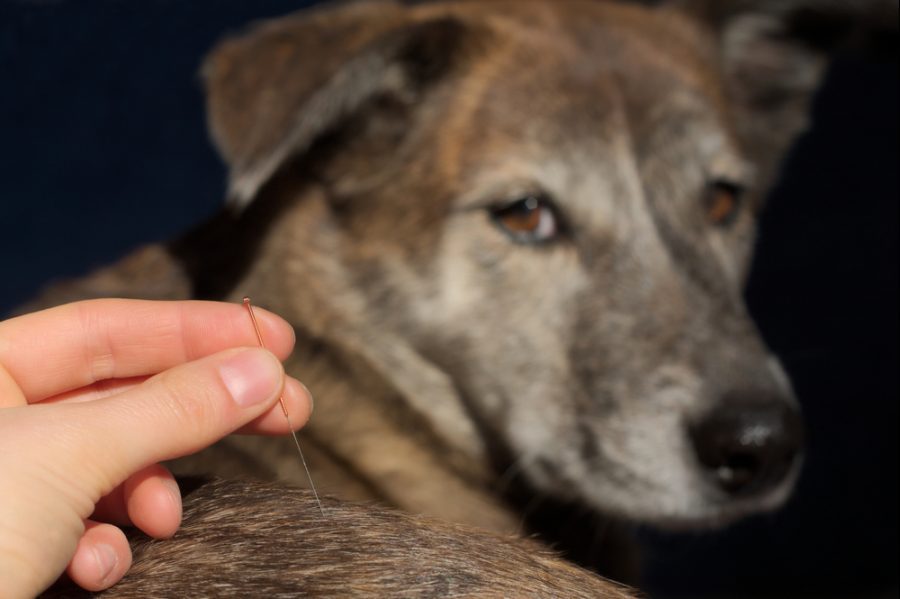Acupuncture has been shown to effectively improve nervous system disorders in veterinary patients in ways more conventional medical approaches cannot.
Can acupuncture help veterinary patients with paralysis from disc disease, peripheral nerve injury, and even incontinence? Often, yes! Some of the most rewarding outcomes in veterinary acupuncture result from treating animals who have lost the ability to stand or bear weight on a limb. Examples include dogs paralyzed in the hind end from intervertebral disc disease (IVDD) or traumatic injury to the spinal cord,i and horses with radial nerve injury.ii Any of these conditions could lead to euthanasia if the individuals are unable to recover, so an effective and safe integrative medical approach such as acupuncture can be key to keeping them alive and restoring functional mobility.iii
Wheres the science behind acupuncture?
Acupuncture has the most well-researched substantiation of any integrative therapy approach. Consequently, we no longer need to guess at how it works or attribute its actions to mythical, mystical processes. For example, acupuncture reduces hyperactivity in the sympathetic, or fight-or-flight, portion of the nervous system. This leads to less anxiety, inflammation, and cardiovascular arousal, and paves the way for a calmer, recuperative inner state. Alternatively, when nerves fail to fire sufficiently, as in the case of CNS or peripheral nerve injury, acupuncture can induce changes that encourage neural pathways to heal and participate more fully in neural networks that control whole-body function.
Acupuncture also controls pain, which for nervous system disorders in veterinary patients may arise from impaired circulation, damage to nerves in the CNS or the periphery (e.g. the limbs), or from compression of nerve branches due to constrictive soft tissues.iv For these conditions, medications may fail to control pain or adequately resolve the issue, whereas acupuncture may be able to.v vi Furthermore, acupuncture reduces inflammation,vii facilitates tissue repair,viii-10 improves circulation,11 and strengthens the patients overall health.12
Does acupuncture need to involve needling?
Creating a relaxing and comfortable atmosphere and treatment technique is paramount to producing a fear-free, comforting session. As such, needle number, gauge, location, depth, and method of stimulation depend on the patient. The canine patient shown in Figure 1 is relaxing during his acupuncture treatment for neck tension. Ideally, acupuncture patients require little to no restraint during treatment and are allowed to rest in a recumbent position on a soft and padded surface. Sometimes, veterinary patients tolerate only a few extremely thin needles. In cases where they are just too sensitive, the practitioner can substitute acupressure or laser to activate the points.

What is electroacupuncture about?
Electroacupuncture (EA), depicted in Figure 2, enhances the effects of needling through a variety of mechanisms. EA blocks pain by modifying the release of various bioactive chemicals in the central, peripheral, and autonomic nervous systems. It accentuates the release of opioidergic neurotransmitters in the periphery; these, in turn, desensitize peripheral nociceptors and reduce levels of pro-inflammatory cytokines in both peripheral nerves and the spinal cord. Other neurotransmitters involved in EA-induced analgesia include norepinephrine and serotonin as well as the endogenous cannabinoid, anandamide.
EA has notable anti-inflammatory effects. It induces the release of endogenous opioids from macrophages and monocytes, lymphocytes, and granulocytes in inflamed tissue. EA may also enhance the migration of opioid-containing cells to an inflamed region, elevating the local concentration of opioids. These substances then activate receptors in peripheral nerve terminals to suppress nociceptive signaling. Moreover, EA elevates the amount of endocannabinoid receptors (CB2) in immune cells as well as the endocannabinoid ligand, anandamide, in inflamed tissue. For tissue regeneration, EA enhances endogenous stem cell proliferation and differentiation, adding to the beneficial effects of mesenchymal stem cell administration.

What would an acupuncture treatment look like for a dog with disc disease?
Figure 3 describes an anatomically based treatment protocol for a dog with hind limb paralysis from TL IVDD. It includes acupuncture points in the paraspinal region that would assist with recovery of compromised spinal cord segments and aid in protecting and regaining neuromotor function. Adding the acupuncture point Stomach 36 (ST 36) at the motor point of the cranial tibialis muscle fosters the promulgation of signals that participate in long-loop reflexes from the crus to the nucleus tractus solitarius (NTS) in the brainstem. The NTS cross-talks with the dorsal motor nucleus of the vagus nerve; in so doing, it supports parasympathetic function. This assists with immune system and digestive autoregulation. The point protocol includes patient-specific sites where the practitioner identifies myofascial dysfunction, typically denoted as local points on the record.

Clinical research on acupuncture
A growing number of publications detail the mechanisms of acupuncture and summarize scientific evidence of its effectiveness for neurologic problems. With reference to IVDD specifically, studies involving acupuncture, electroacupuncture, and aquapuncture highlight the effectiveness of this modality in restoring function and providing pain relief.13-19 For dogs with thoracolumbar disc disease, acupuncture has a strong track record, making the case for its inclusion in the routine approach to this relatively common condition.
Recent research has further elucidated acupunctures underlying mechanism of action for fostering nerve repair via nervous system remodeling. Acupuncture encourages neural regeneration and axonal sprouting by activating the retrograde transport of neurotrophins. Nerve growth factor, brain-derived neurotrophic factor, glial cell-derived neurotrophic factor, N-cadherin, and microRNAs represent some of the most significant substances affected by acupuncture. To quote a recent study: Acupuncture not only reverses the poor remodeling of the nervous system (in response to injury) but also stimulates the release of neurotrophic substances such as nerve growth factors in the nervous system to ameliorate pain and promote the regeneration and repair of nerve fibers. In conclusion, the neurologic remodeling at the peripheral and central levels in the process of acupuncture treatment accelerates nerve regeneration and repair. These findings provide novel insights enabling the clinical application of acupuncture in the treatment of PNI (peripheral nerve injury).20
Conclusion
Acupuncture effectively improves a gamut of nervous system disorders in veterinary patients, and in ways more conventional medical approaches simply cannot. Mounting evidence for its use, along with clear, scientifically-based mechanisms of action, qualify acupuncture as a first-line consideration early in the treatment process to optimize outcomes and maximize the chances of full recovery.








